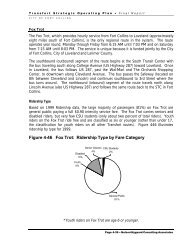Pioneer Daily Chores station
Pioneer Daily Chores station
Pioneer Daily Chores station
You also want an ePaper? Increase the reach of your titles
YUMPU automatically turns print PDFs into web optimized ePapers that Google loves.
Bobcat Ridge 4 th Grade <strong>Pioneer</strong> Program<br />
<strong>Daily</strong> <strong>Chores</strong> Station<br />
This is one of four <strong>station</strong>s in the pioneer program designed for 4 th grade classes.<br />
Setting: Inside the <strong>Pioneer</strong> Cabin.<br />
Theme: Everyone in the family—even all the children—had to contribute to making a living 100 years ago.<br />
Description: Children learn what it was like to live in the pioneer cabin; learn about the first family that built and<br />
lived in the cabin; and discover some of the chores that children would have done to help the family.<br />
Time: 25-35 minutes<br />
Recommended Group Size: 10-15<br />
Materials:<br />
Photos of cabin and family that lived there<br />
Chore jar<br />
Buckets for carrying water<br />
Large wash bucket<br />
Washboard<br />
Bandanas<br />
Bar of soap<br />
Clothes line and clothes pins<br />
Leader Notes:<br />
Introduction:<br />
Welcome students to school. Introduce self. Have the children look around the inside of the cabin (the<br />
cabin was built in 1917). Point out the chinking between the logs (this was redone by the Natural Areas staff to<br />
resemble the original chinking. This kept out the cold weather in the winter, and kept the cabin cool in the<br />
summer). Ask them how the size of the cabin relates to the size of their bedroom. Tell them that the original<br />
family that built and lived in the cabin were a mom and dad, and three kids! (The family that built the cabin is<br />
the Kitchen family—they are the same ones that later bought and ran the Masonville Store (in 1921. At the Local<br />
Economy <strong>station</strong>, the Kitchen family is the one who runs the store) The kids slept in a loft just under the roof.<br />
(Show photos of the cabin and family.) Invite them to think about things like:<br />
• How would the family stay warm? (wood burning stove)<br />
• What would they cook on? (wood burning stove)<br />
• Where would they go to the bathroom? (outhouse)<br />
• Where would they get water? (from the pump outside or from a stream)<br />
Have them think about all the things they would use water for:<br />
• taking baths (only once a week, everyone in the family using the same water)<br />
• washing clothes (probably done on Mondays)<br />
• drinking (brought in from the pump and put in a bucket with a dipper to drink from)<br />
• watering the animals (carried by buckets to water troughs for the horses and cattle)<br />
• cooking food (brought into the house in buckets)
Body:<br />
Remind students that everyone in the family was important to helping the family survive and make a living.<br />
Even the smallest children had jobs to do. Ask them to share with you chores that they do at home. Some of<br />
these are similar to what children might have had to do 100 years ago, but there are other chores that many kids<br />
today have never done.<br />
Show children the “chore jar.” Explain that it contains a bunch of jobs that kids might have had to do to<br />
help the family. Sit in a circle and have each child pick out a job from the jar. Go around the circle and have<br />
them read their chore, and then discuss what that job entailed and why it was important to the family. If there<br />
are enough chores in the jar for a second round (and if there is time), do it again. Ask them what chores they<br />
would like and which they would not want to do.<br />
Remind them about all the needs a family would have for water, and that it would have to be brought<br />
into the house. Take kids to the water well and pump. Let them pump water into the two buckets and take<br />
turns carrying it to the cabin. Water is heavy—ask them why they think the pump is so close to the cabin (don’t<br />
have to carry it as far!).<br />
Pour one bucket of water into the large washtub. Explain how people didn’t have electricity or washing<br />
machines. Demonstrate with the washboard and soap how clothes were washed. Let children take turns<br />
washing bandanas, rubbing soap onto the board and rubbing the bandana against the washboard to push the<br />
soap through. Have several children pick up the washtub together and dump the water behind the cabin (away<br />
from the areas where people walk). Fill the washtub with the other bucket of water. Have the children rinse the<br />
bandanas in the clean water. Dump out the washtub again and hang out the handkerchiefs on the clothes line to<br />
dry (this can be tied from a couple of trees behind the cabin before the session begins).<br />
Summarize:<br />
Everyday life was harder a century ago than it is today, especially in areas like Bobcat Ridge. Everyone in the<br />
family had to do their part, and every job was important.<br />
Extension:<br />
How do chores today compare with 100 years ago? Think about how you would have rationed water for all the<br />
uses you needed it for. Do you need electricity to stay clean? How can we help save water today?<br />
This lesson was created by Deborah Price and Eileen Sake.<br />
September 2008; revised September 2010.




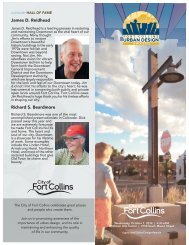


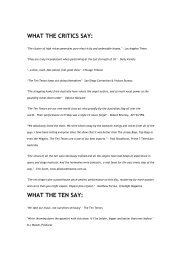

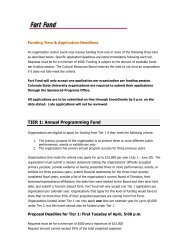

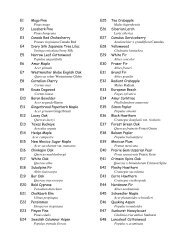


![Fort Collins Tree ID Study Guide [Compatibility Mode]](https://img.yumpu.com/20764911/1/190x135/fort-collins-tree-id-study-guide-compatibility-mode.jpg?quality=85)
